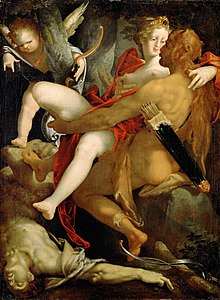Our website is made possible by displaying online advertisements to our visitors.
Please consider supporting us by disabling your ad blocker.
Northern Mannerism

Northern Mannerism is the form of Mannerism found in the visual arts north of the Alps in the 16th and early 17th centuries.[1] Styles largely derived from Italian Mannerism were found in the Netherlands and elsewhere from around the mid-century, especially Mannerist ornament in architecture; this article concentrates on those times and places where Northern Mannerism generated its most original and distinctive work.
The three main centres of the style were in France, especially in the period 1530–1550, in Prague from 1576, and in the Netherlands from the 1580s—the first two phases very much led by royal patronage. In the last 15 years of the century, the style, by then becoming outdated in Italy, was widespread across northern Europe, spread in large part through prints. In painting, it tended to recede rapidly in the new century, under the new influence of Caravaggio and the early Baroque, but in architecture and the decorative arts, its influence was more sustained.[2]
- ^ The different definitions of what constituted Italian Mannerism are notorious, and have a knock-on effect in defining the northern versions. For the purposes of this article, the term is used broadly in the sense set out in Shearman (pp. 15–32 in particular), though in a rather wider sense when ornament is discussed. See Smyth, and especially its Introduction by Cropper for an account of the differing ways the term has been used by art historians.
- ^ See, for example, Simon Jervis, Printed Furniture Designs Before 1650 (Furniture History Society), 1974.
Previous Page Next Page


